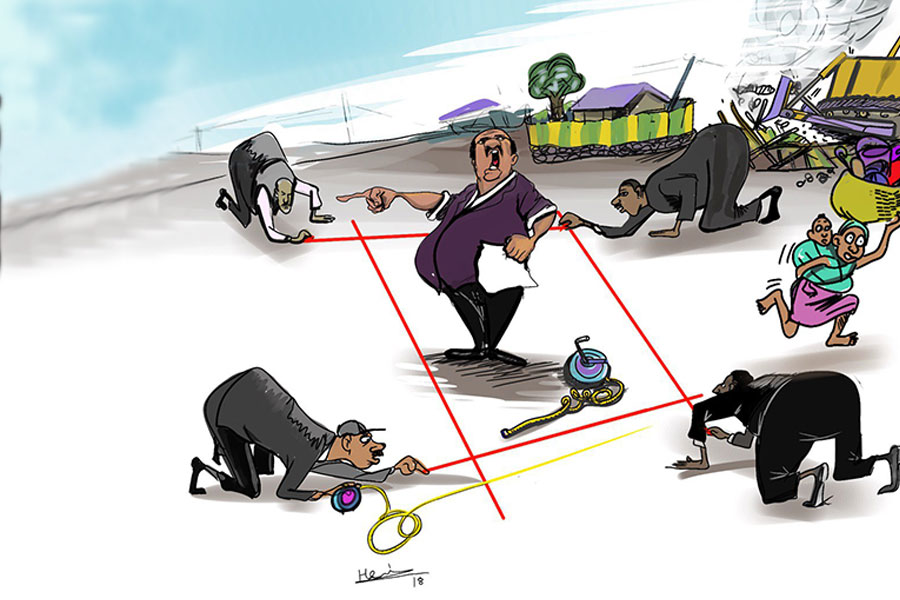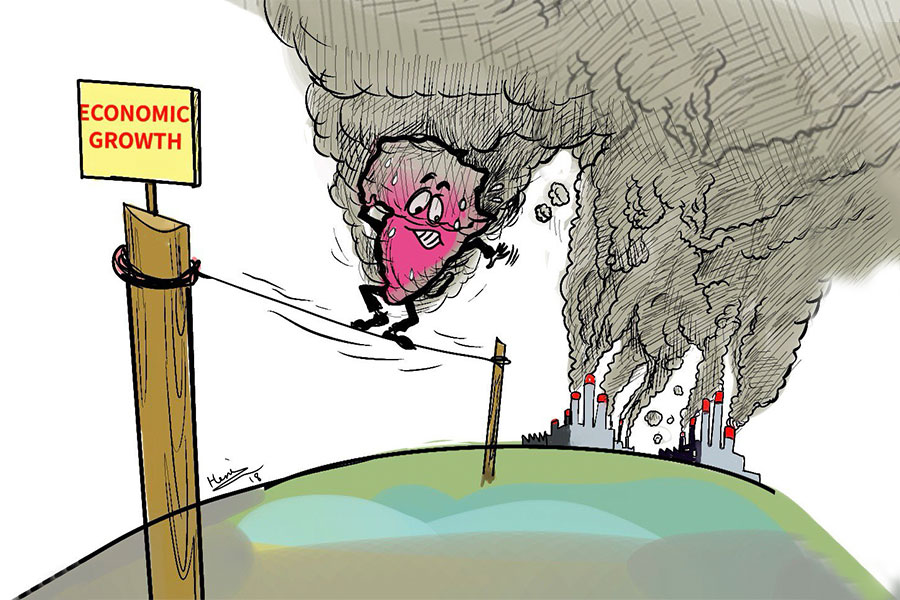Late one evening, Hiwot Muluken, 25, stepped unknowingly into an open elevator shaft on the second floor of a condominium in the Bole Arabsa neighborhood.
She earned 7,000 Br a month as an office assistant and lodging from her private employer. But the fall left her with severe injuries that took two months to heal. Hiwot recalled the physical pain was excruciating, and emotional distress followed her throughout her recuperation. Even last week, she struggled to discuss that dark night without pausing to reflect on how close she came to demise.
“It's night, and there was no light,” she recalled. "Everything was terrible."
For Hiwot, it was a sudden lesson on how quickly one small oversight — a missing or poorly installed elevator door — can alter a life.
In a private condominium near Urael Church, on Haile Gebresellasie St., Mekdes Abessa lives on the eighth floor but no longer trusts her building’s elevator. A loud crash reverberated through the corridors a month ago at eight pm in the evening. Mekdes feared someone was hurling rocks, only to learn it was the elevator plunging from the seventh floor to the ground. Fourteen people were inside at the time, facing a heart-stopping drop.
“We thought someone was throwing rocks in the corridor," she said. "It's the elevator descending out of control.”
No one was killed, but the psychological impact lingered.
“We don’t trust it, especially after the incident,” said Mekdes.
The building has two elevators, yet one has been out of service for a long time, and the other remains unpredictable.
Such incidents expose a deeper problem. Elevator-related accidents are unusual but can be deadly. Three deaths were recorded in 2022, with one fatality involving a visually impaired man in the Qality area and another near the National Theatre. Both cases were linked to elevator malfunctions, says Nigatu Mamo, public relations officer of the Addis Abeba City Administration Fire & Disaster Risk Management Commission.
While the tally might seem low, the implications are serious for a rapidly expanding metropolis. Infrastructure is sprouting quickly, often without strict adherence to construction guidelines and codes or thorough safety checks. A single oversight in the final stages of a project can open the door to tragedy.
Much of the problem arises from gaps between design and execution. Ethiopia imports a variety of elevators from different countries, with inconsistent standards. Delays in installation are common, and a shortage of skilled technicians means that maintenance may be sporadic even after an elevator is placed. Open shafts, intended for elevator systems, sometimes remain exposed for months or even years. Unsuspecting residents walk through half-finished hallways that expose them to risks.
In Addis Abeba, concerns over building standards have been growing as the city rushes to accommodate millions of residents. The city's construction authorities have found many structures operating without valid work permits, often straying from approved designs. Buildings that fail to accommodate people with disabilities or omit essential safety features, like emergency exits or proper lighting, further exacerbate the risks.
Henok Regassa, director of Building Construction Service Permit Inspection, believes it is an old issue that has grown over time. He observed that previous gaps in the construction regulations created an environment where some developers completed structural work but neglected critical finishing details. He advocates for unannounced inspections, as experience has taught him that building owners might conceal shortfalls when expecting inspection visits instead of addressing them.
When inspectors did make surprise visits, they took action against 113 buildings. During standard inspections, 150 others were flagged for breaches, despite awareness campaigns promoting compliance. In a city where more than 52,000 buildings stand taller than one storey, policing code violations is no small task. Penalties vary from hefty fines between 50,000 Br and 100,000 Br to confiscation of equipment and revocation of business licenses.
These steps are meant to deter negligence, but some developers and owners proceed without permits or wait until confronted by the authorities.
The Addis Abeba City Housing Development Corporation (AACHDC) is central in issuing service permits. According to Fekadu Alemu, Deputy General manager for the construction department at the corporation, older and newer projects differ in regulatory paths. More than 2,000 existing buildings lack official permits, according to Fekadu.
Condominium complexes, a major part of the government’s housing strategy, face their own set of constraints. In certain cases, residents of condominiums popularly known as 60/40 had to move in before elevators were installed, suddenly amplifying the demand for vertical transport. The Corporation contracted six companies to supply 1,385 elevators. Only 592 arrived, with 275 installed; another 220 lie waiting for three-phase electricity before they can be tested or used.
“The public urgently requires elevators," Fekadu told Fortune.
More than 1,200 are yet to be tendered, projected to cost the city no less than 14.5 billion Br, on top of existing debts of over 36 billion Br from previous housing projects. According to importers, price of an eight-person elevator has soared from 4.5 million Br to about 7.5 million Br, a troubling indicator for a city trying to build affordable housing.
Dharma Trading PLC, the largest order recipient, secured contracts worth over 909 million Br. Importing an elevator could take at least four months, providing an opening for developers who import them independently. Without expert input, they might buy items of questionable quality, leading to repeated breakdowns. According to most international guidelines, a functional elevator should have load sensors, emergency alarms, and a qualified service provider on call.
The variability in elevator prices is important, determined by origin, capacity, and available features. Maintenance is broadly categorised into preventive, corrective, and breakdown services, yet building owners often skip routine checkups. The city also suffers from recurring power cuts and unstable voltage levels, raising the possibility of sudden outages while passengers are in mid-ride. Ideally, backup systems or generators should engage, but these can be costly additions that owners may not prioritise.
Robust enforcement and rigorous standards help keep elevator operations safe. China, for example, experienced a massive rise in the number of elevators, from about 360 million in 2014 to nearly 965 million in 2022. Between 2014 and 2021, there were 391 reported elevator accidents there, with an annual death rate surpassing 31.
Five Star Elevator & Lift, a Chinese firm that established a branch in Dukem six years ago, demonstrates the promise and the complications. It received orders for more than 700 elevators, yet only 350 have arrived so far. Of those, 120 function properly, while the rest remain idle, awaiting stable three-phase power or completion of the buildings they will serve. Each unit holds eight people, costs around four million Birr, and requires up to three weeks for mechanical and electrical installation. Skilled labour is in limited supply, and even firms employing over a hundred specialists find themselves stretched thin.
“Elevator service is similar to air transport,” said the company’s Marketing Officer, Amanuel Mengistu. "It requires regular checks as a preventative measure."
HD Electro-Mechanical Engineering has imported 113 elevators over six years. Its General Manager, Habtamu Baynak, blamed shipping bottlenecks and the prevalence of unlicensed vendors. In one instance, an elevator from Turkey showed up missing crucial internal parts, halting installation mid-way.
“Unlike neighbouring countries, Ethiopia does not have standards for elevators,” he said.
Though Ethiopia’s elevator numbers are smaller, the lessons are instructive. Ignoring maintenance and safety protocols eventually leads to tragic outcomes.
Another supplier, GAD Electro-Mechanical Work Plc., submitted its findings to condominium associations warning about external factors, like frequent overloading, and internal flaws, such as missing overload sensors and the absence of emergency stop mechanisms. The company is among the largest importers, buying the machines from Spain, where costs for a five-stop model can reach six million Birr, about double that of a Chinese counterpart.
Major clients like banks or large hotels often prioritise durability and pay the higher price. However, its General Manager, Getachew Teklemariam, observed some developers and property owners buy elevators that quickly malfunction due to inferior components.
“They neglect to consider how elevators work," he told Fortune. "They're unwilling to consult professionals.”
Firefighters at the Addis Abeba Fire Department frequently handle calls from people trapped in stalled elevators.
Ordinary users like 29-year-old customer service officer, Yordanos Zeray, feel the inconvenience. Working at the School of American English Language Centre, she sometimes waits 20 minutes for the elevator to respond.
“It encounters problems consistently,” she said.
In July 2024, the elevator was out for an entire month, causing older people and children to miss classes or struggle up the stairs.
“It's continuously repaired, but it always breaks down,” she said.
The frustration lies in the financial and logistical burdens of unplanned repairs, which can involve importing parts or finding a qualified technician.
Ideally, buildings should keep a backup generator on site and employ a dedicated technician ready to troubleshoot mechanical problems. But in reality, many owners deem these safeguards too costly. The results are delays in rescues and a steady flow of phone calls to emergency services. Some properties experience multiple elevator failures in a week, particularly during peak electrical fluctuation.
A civil engineering professor at Addis Abeba University, Abebe Dinku (Prof.), observed a lack of awareness about how hazardous elevators can be when improperly installed or maintained. Even a single bolt failure can lead to catastrophic events.
Eight injuries have been reported this year, including one incident in which a cable snapped in a condominium built by a private real estate developer. Though fatalities are less common, accidents three years ago in Qality and near the National Theatre illustrated the lingering dangers. In both cases, doors opened prematurely, sending people stepping into empty air.
“It should have opened when the box arrived,” Nigatu said, stating the importance of carefully calibrated sensors.
According to Abebe, cost-cutting drives often cause developers to deviate from the initial plans, substituting cheaper materials or entirely omitting key components.
“If an elevator breaks down, it takes a long time to repair due to the lack of material and experts,” he said.
Abebe finds it disheartening to see residents of high-rise condominiums climbing 18 floors on foot because their elevator has been offline for weeks or months. An elevator’s capacity should match a building’s daily traffic. In practice, such coordination is rare. With shipping delays and a dearth of skilled professionals, it can mean extended periods in which a newly built tower has no functioning lift.
Hiwot still vividly remembers her fall. She feels a jolt of fear whenever she walks down a poorly lit corridor or passes an exposed shaft. Mekdes, too, steels herself every time she sees the battered elevator door, a reminder of the uncontrolled drop that could have turned out so much worse.
Officials note that death rates remain relatively low, but acknowledge each new building and new malfunction points to the possibility of a more devastating incident if the causes — absence of standards, erratic power supply, lack of skilled labour, and hasty construction — remain unaddressed.
Unannounced inspections, fines, and a handful of importers are the city’s main defenses for now. However, whether they can keep pace with Addis Abeba’s relentless march skyward remains to be seen. Many residents hope that improved collaboration between city officials, developers, and experts will finally turn the pages for the better.
PUBLISHED ON
Apr 06,2025 [ VOL
26 , NO
1301]

Dec 22 , 2024 . By TIZITA SHEWAFERAW
Charged with transforming colossal state-owned enterprises into modern and competitiv...

Aug 18 , 2024 . By AKSAH ITALO
Although predictable Yonas Zerihun's job in the ride-hailing service is not immune to...

Jul 28 , 2024 . By TIZITA SHEWAFERAW
Unhabitual, perhaps too many, Samuel Gebreyohannes, 38, used to occasionally enjoy a couple of beers at breakfast. However, he recently swit...

Jul 13 , 2024 . By AKSAH ITALO
Investors who rely on tractors, trucks, and field vehicles for commuting, transporting commodities, and f...

Oct 4 , 2025
Eyob Tekalegn (PhD) had been in the Governor's chair for only weeks when, on Septembe...

Sep 27 , 2025
Four years into an experiment with “shock therapy” in education, the national moo...

Sep 20 , 2025
Getachew Reda's return to the national stage was always going to stir attention. Once...

Sep 13 , 2025
At its launch in Nairobi two years ago, the Africa Climate Summit was billed as the f...